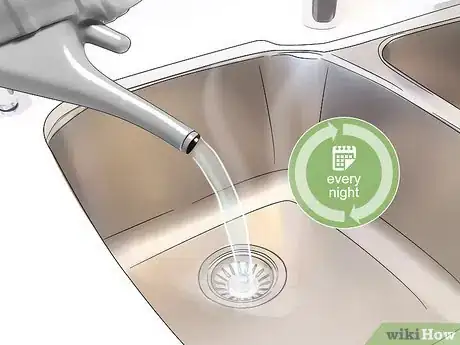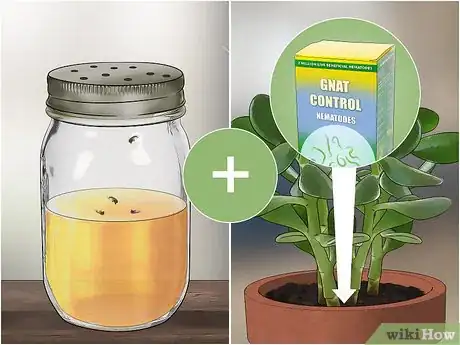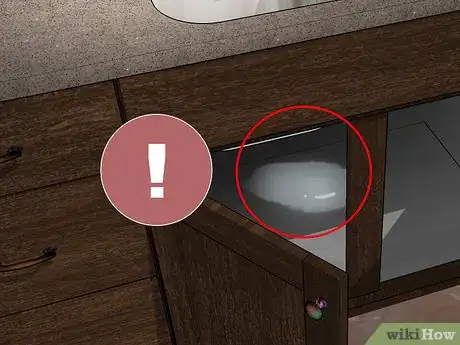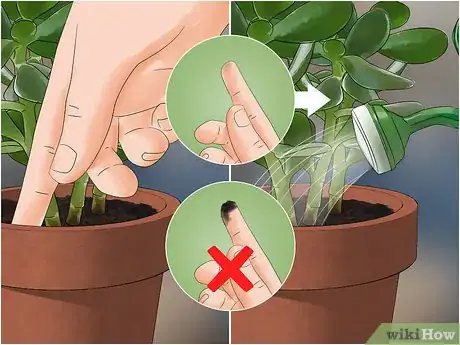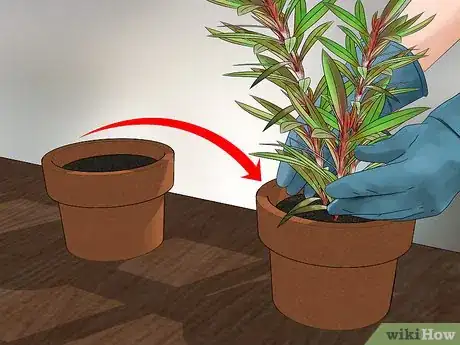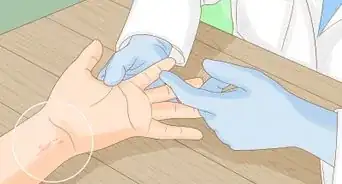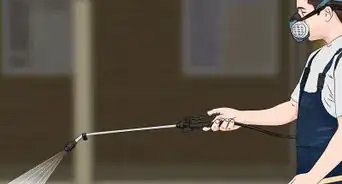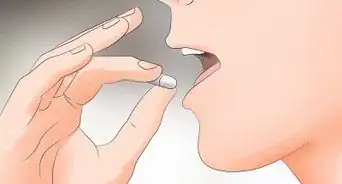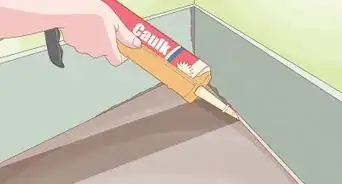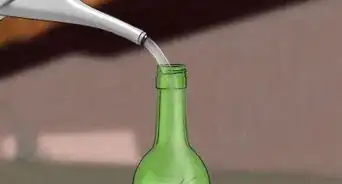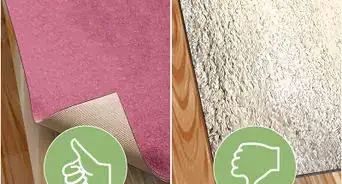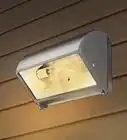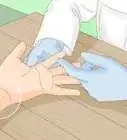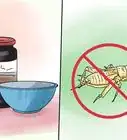This article was co-authored by Kevin Carrillo. Kevin Carrillo is a Pest Control Specialist and the Senior Project Manager for MMPC, a pest control service and certified Minority-owned Business Enterprise (MBE) based in the New York City area. MMPC is certified by the industry’s leading codes and practices, including the National Pest Management Association (NPMA), QualityPro, GreenPro, and The New York Pest Management Association (NYPMA). MMPC's work has been featured in CNN, NPR, and ABC News.
There are 8 references cited in this article, which can be found at the bottom of the page.
wikiHow marks an article as reader-approved once it receives enough positive feedback. This article received 82 testimonials and 98% of readers who voted found it helpful, earning it our reader-approved status.
This article has been viewed 15,776,456 times.
Few insects are quite as pesky as gnats. Fortunately, dealing with them is relatively easy. If gnats have been buzzing around your sinks and drains, scrub away grimy deposits in the pipes where they lay their eggs. Traps can cut down the number of adult flies and help you monitor the infestation's severity. Cutting off gnats' food supply is crucial, so store food in sealed containers, wipe up spills, and keep your trash bins covered and clean. With a little diligence, you can turn your home into a fly-free zone.
Household Fixes
If you have gnats that you want to deal with right now, you may already have everything you need at home:
- If you have a wire brush or an enzymatic drain cleaner, you can stop gnats from breeding in your drains.
- If you have apple cider vinegar and a mason jar, you can make a gnat trap.
- If you have red wine and liquid soap, you can make a wine trap.
- If you have gentle hand or dish soap, you can make a spray for your plants.
Steps
Dealing with Gnats in Sinks and Drains
-
1Scrub inside the drain pipe to remove organic matter. Grime that builds up inside drain pipes is the perfect breeding ground for gnats. Use a wire brush or pipe cleaner to scrape away stubborn deposits of organic matter.[1]
- After scrubbing the drain, bring a pot of water to a near boil, then pour it down the drain to clear the debris you’ve scraped.
- Bleach, ammonia, vinegar, and other cleaning products won’t cut through deposits in your drain pipes.
-
2Clear your drains with an enzymatic, foaming cleaner. If you can’t access your drain pipes with a wire brush, there are foaming products designed to eat away organic matter. Look for a product with "enzymatic" in its name or description at a hardware store. Pour it down the drain according to the label’s instructions, then let it sit overnight.[2]
- After letting the cleaner sit, pour near-boiling water down the drain.
- Foaming products work better than liquid cleaners.
- If you’re concerned about putting chemicals down your drain, there are eco-friendly, non-toxic enzymatic drain cleaners available.[3]
Advertisement -
3Clean your drain with hot water nightly to prevent slimy buildup. Pouring hot water down your drain every night is the best way to keep your pipes clear. Aside from enzymatic drain cleaners, you should avoid pouring chemicals down your drains.
- Bleach, ammonia, vinegar, and other household products can erode pipes, especially older cast iron pipes.
- Additionally, cleaning products can react with other chemicals in your pipes. A harmful reaction could produce dangerous fumes or pressure strong enough to burst a pipe.
- Don’t pour insecticide down the drain, as harsh pesticides can have negative environmental impacts.[4]
Making Gnat Traps
-
1Trap gnats in a jar filled with vinegar. Find a used can or jar, and fill it about halfway with apple cider vinegar. Mix in a drop of dish soap to break the surface tension, which will help prevent trapped gnats from escaping. Leave the jar in an area you've seen gnats buzzing about, such as your kitchen or dining room.[5]
- After you fill your can or jar, you could seal the lid and poke small holes in it with a nail or screw. That way, any gnats that don’t drown in the vinegar can’t escape.
- You could also cut a 2 liter (0.53 US gal) plastic bottle in half, and add vinegar to the bottom half. Place the top, or the part with the narrow nozzle, upside down into the base. It should look like a funnel when you're done. Gnats will follow the vinegar scent to find their way into the trap, but they'll have a hard time getting out through bottle's narrow top.
- If you don't have apple cider vinegar on hand, any type of vinegar will do. Other effective baits include beer or mashed banana.
-
2Try making a wine and soap trap. Fill a small cup about halfway with red wine, then mix in a drop of a dish soap. Leave the cup out on your table or countertop to attract pesky gnats.[6]
- The next time you have friends over for drinks, pour an extra cup of wine with dish soap to keep gnats away from your guests’ glasses. Just make sure you clearly mark the cup that has dish soap to avoid confusion.
-
3Use traps in combination with other management methods. Traps can help you monitor an infestation and decrease the number of adult gnats in your home. However, on their own, traps aren’t an effective way to manage an infestation.[7]
- In order to eliminate gnats completely, you’ll need to combat all stages of their life cycle. Traps only kill adult gnats; they do nothing to fight eggs or larvae.
Preventing Gnat Infestations
-
1Remove food sources that attract gnats. Tidy your kitchen and dining room regularly, wipe up spills immediately, and promptly wash used pots, dishes, and utensils. Store fruit, especially ripened fruit, in the refrigerator.[8]
- Always keep food in airtight containers stored in a closed cabinet or refrigerator.
- Keep your eye out for sneaky spills, such as a little fruit juice by the fridge or a forgotten onion in the back of the pantry. Unnoticed messes could breed thousands of gnats.
-
2Cover your garbage and recycling bins. Keep all of your bins covered, including those outside. Check their exteriors for spills and food residue regularly, and wipe away any messes with a mild bleach solution.[9]
- Avoid keeping full bags of trash in the house overnight.
- It’s wise to rinse out empty bottles and cans before throwing them in your recycling bin.
-
3Check doors and windows for holes, gaps, and cracks. Repair any tears in window screens, and add weatherstripping to gaps around doors and window frames. Avoid leaving doors and unscreened windows open. Look for holes and vents on your home’s exterior, and seal them with caulk or fine mesh screens.[10]
- Some gnats are small enough to fit through mesh screens, so you might want to keep your windows closed, even if they’re screened.
-
4Try to eliminate damp spots in your home. Gnats thrive in moist places, so look out for damp corners in the kitchen, bathroom, and other areas of the house. Wipe damp spots down with a mild bleach solution or household cleaner, then dry them with a clean cloth. Store wet towels and clothes in a lidded hamper, and wash dirty mop heads thoroughly before hanging them to dry.[11]
- Check the areas beneath kitchen and bathroom sinks, and repair any leaks you find.
- Keep your blinds and curtains open to let sunlight into your home. Daylight can help prevent dampness.
- You could also use a humidity monitor and dehumidifier to keep humidity levels in your home below 50%.
Keeping Gnats out of Your Plants
-
1Allow the soil to dry out before you water your houseplants. Soil that’s constantly damp attracts pests, including gnats, and promotes mold growth. While you shouldn’t let your plants wilt or turn yellow, try to hold off watering until the soil is completely dry.
- To test the soil, stick your finger about 1 to 2 inches (2.5 to 5.1 cm) into the surface. If dirt sticks to your finger, it’s probably best to hold off watering, unless your plants look sad.
- It’s also best to use containers with drainage holes in the bottom. If your pots sit on saucers that collect excess water, be sure to drain them after you water your plants.
EXPERT TIPKevin Carrillo is a Pest Control Specialist and the Senior Project Manager for MMPC, a pest control service and certified Minority-owned Business Enterprise (MBE) based in the New York City area. MMPC is certified by the industry’s leading codes and practices, including the National Pest Management Association (NPMA), QualityPro, GreenPro, and The New York Pest Management Association (NYPMA). MMPC's work has been featured in CNN, NPR, and ABC News.MMPC, Pest Control Specialist
 Kevin Carrillo
Kevin Carrillo
MMPC, Pest Control SpecialistOur Expert Agrees: Gnats are attracted to oversaturated soil; let the soil in your potted plants dry out completely before watering them again. You can also scoop off the top inch of soil. Doing this, you'll notice that your gnat population will decrease after a couple of weeks.
-
2Add beneficial nematodes to your soil. Nematodes are tiny worms that eat the larvae gnats, fleas, and other pests. You can purchase them at a garden center; look for a product labeled for gnat control that contains the nematode species Steinernema feltiae.
- Typically, you mix beneficial nematodes with water, then add the mixture to your soil. Check your product’s label for specific instructions.
- Beneficial nematodes are safe for people, plants, and pets, so try not to get grossed out or worry about harmful health effects.
-
3Make a homemade gnat spray with gentle liquid soap and water. Mix a teaspoon or less of gentle hand or dish soap with a 1 US pint (470 mL) of lukewarm water. Add the mixture to a spray bottle, then spritz your plants’ leaves. After 2 or 3 hours, rinse the leaves thoroughly with water.[12]
- While they’re more expensive, you can also purchase insecticidal plant soaps at a garden center.
- Using a homemade soap spray increases the risk of leaf damage. It’s wise to test the spray on a small area before spraying an entire plant. As a rule of thumb, if a soap dries out or irritates your skin, it’s probably too harsh for your plants.
-
4Repot your plants if other methods don’t work. If you haven’t had success keeping flies out of your plants, it’s time to transplant them. Water the plant, remove it from the old pot, then gently shake away as much soil as possible from the root system.[13]
- Fill a new pot nearly to the top with fresh potting soil. Dig a hole in the center large enough to accommodate the roots, bury them, then cover them with soil.
- If your gnat problem persists after transplanting, you might need to resort to chemical treatment. Head to your local garden center for a plant-safe liquid insecticide labeled for flying insects.
Expert Q&A
Did you know you can get expert answers for this article?
Unlock expert answers by supporting wikiHow
-
QuestionWhere are the gnats in my home coming from?
 Kevin CarrilloKevin Carrillo is a Pest Control Specialist and the Senior Project Manager for MMPC, a pest control service and certified Minority-owned Business Enterprise (MBE) based in the New York City area. MMPC is certified by the industry’s leading codes and practices, including the National Pest Management Association (NPMA), QualityPro, GreenPro, and The New York Pest Management Association (NYPMA). MMPC's work has been featured in CNN, NPR, and ABC News.
Kevin CarrilloKevin Carrillo is a Pest Control Specialist and the Senior Project Manager for MMPC, a pest control service and certified Minority-owned Business Enterprise (MBE) based in the New York City area. MMPC is certified by the industry’s leading codes and practices, including the National Pest Management Association (NPMA), QualityPro, GreenPro, and The New York Pest Management Association (NYPMA). MMPC's work has been featured in CNN, NPR, and ABC News.
MMPC, Pest Control Specialist
-
QuestionDoes hydrogen peroxide get rid of gnats?
 Kevin CarrilloKevin Carrillo is a Pest Control Specialist and the Senior Project Manager for MMPC, a pest control service and certified Minority-owned Business Enterprise (MBE) based in the New York City area. MMPC is certified by the industry’s leading codes and practices, including the National Pest Management Association (NPMA), QualityPro, GreenPro, and The New York Pest Management Association (NYPMA). MMPC's work has been featured in CNN, NPR, and ABC News.
Kevin CarrilloKevin Carrillo is a Pest Control Specialist and the Senior Project Manager for MMPC, a pest control service and certified Minority-owned Business Enterprise (MBE) based in the New York City area. MMPC is certified by the industry’s leading codes and practices, including the National Pest Management Association (NPMA), QualityPro, GreenPro, and The New York Pest Management Association (NYPMA). MMPC's work has been featured in CNN, NPR, and ABC News.
MMPC, Pest Control Specialist Yes, hydrogen peroxide applied to the soil of houseplants can help destroy the larvae of fungus gnats. However, you will need to dilute it so you don’t damage your plants. Use a 3% solution and dilute it with water (1 part hydrogen peroxide to 4 parts water), then pour it around the base of the plant as if you were watering it. Do this once a week until the gnats are gone.
Yes, hydrogen peroxide applied to the soil of houseplants can help destroy the larvae of fungus gnats. However, you will need to dilute it so you don’t damage your plants. Use a 3% solution and dilute it with water (1 part hydrogen peroxide to 4 parts water), then pour it around the base of the plant as if you were watering it. Do this once a week until the gnats are gone. -
QuestionWhat are gnats attracted to?
 Kevin CarrilloKevin Carrillo is a Pest Control Specialist and the Senior Project Manager for MMPC, a pest control service and certified Minority-owned Business Enterprise (MBE) based in the New York City area. MMPC is certified by the industry’s leading codes and practices, including the National Pest Management Association (NPMA), QualityPro, GreenPro, and The New York Pest Management Association (NYPMA). MMPC's work has been featured in CNN, NPR, and ABC News.
Kevin CarrilloKevin Carrillo is a Pest Control Specialist and the Senior Project Manager for MMPC, a pest control service and certified Minority-owned Business Enterprise (MBE) based in the New York City area. MMPC is certified by the industry’s leading codes and practices, including the National Pest Management Association (NPMA), QualityPro, GreenPro, and The New York Pest Management Association (NYPMA). MMPC's work has been featured in CNN, NPR, and ABC News.
MMPC, Pest Control Specialist Gnats love moisture and plant food sources, such as fruits, vegetables, and flowers. They also love honey and vinegar, which is why they make effective bait for traps. Fungus gnats are attracted to damp soil. Gnats also like the heat and moisture produced by human bodies, which is why they tend to swarm you! If you’re wearing hair or skin products that smell like fruit or flowers, they’ll find you even more enticing.
Gnats love moisture and plant food sources, such as fruits, vegetables, and flowers. They also love honey and vinegar, which is why they make effective bait for traps. Fungus gnats are attracted to damp soil. Gnats also like the heat and moisture produced by human bodies, which is why they tend to swarm you! If you’re wearing hair or skin products that smell like fruit or flowers, they’ll find you even more enticing.
References
- ↑ https://www.extension.iastate.edu/news/2005/dec/072301.htm
- ↑ https://agrilifeextension.tamu.edu/wp-content/uploads/2016/05/how-to-get-rid-of-flies-in-house.pdf
- ↑ https://www.mnn.com/your-home/at-home/stories/how-get-rid-drain-flies-naturally
- ↑ https://entomology.ca.uky.edu/ef615
- ↑ http://extension.colostate.edu/topic-areas/insects/flies-in-the-home-5-502/
- ↑ https://www.bobvila.com/articles/how-to-get-rid-of-gnats/
- ↑ https://agrilifeextension.tamu.edu/wp-content/uploads/2016/05/how-to-get-rid-of-flies-in-house.pdf
- ↑ https://entomology.ca.uky.edu/ef621
- ↑ https://agrilifeextension.tamu.edu/wp-content/uploads/2016/05/how-to-get-rid-of-flies-in-house.pdf
- ↑ http://extension.colostate.edu/topic-areas/insects/flies-in-the-home-5-502/
- ↑ https://agrilifeextension.tamu.edu/wp-content/uploads/2016/05/how-to-get-rid-of-flies-in-house.pdf
- ↑ http://extension.colostate.edu/topic-areas/insects/insect-control-soaps-and-detergents-5-547/
- ↑ https://agrilifeextension.tamu.edu/wp-content/uploads/2016/05/how-to-get-rid-of-flies-in-house.pdf
About This Article
To get rid of gnats, first locate the source of the gnats. Gnats tend to lay eggs in drain pipes. If they're coming from the sink, pour boiling water down the drain. If that doesn't work, try making a gnat trap. Find a used can or jar and fill it about halfway with apple cider vinegar. Then, mix in a drop of dish soap to break the surface tension. Seal the jar and poke small holes in the covering. That way, any gnats that don’t drown in the vinegar can’t escape. If you don't have apple cider vinegar on hand, substitute it with any type of vinegar, wine or beer. Gnats are also attracted to overripe food, so you can make an even simpler trap by mashing a banana into the jar instead. Leave the trap in an area you've seen gnats buzzing about, such as your kitchen or dining room. To prevent gnats, make sure you tidy your kitchen, cover your garbage, and eliminate damp spots in your home. If you want to learn how to prevent getting gnats in the first place, keep reading!


